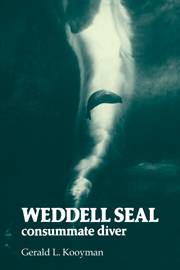Book contents
- Frontmatter
- Contents
- Preface
- Dedication
- Map
- 1 McMurdo Sound
- 2 The Weddell seal
- 3 Breeding, birth, and growth
- 4 Cold
- 5 Diving behavior: Poseidon's pride
- 6 Physiology of diving
- 7 Food habits and energetics
- 8 Under-ice orientation (summer day – winter night)
- 9 Distribution, abundance, and mortality
- 10 Future prospects
- References
- Index
- Frontmatter
- Contents
- Preface
- Dedication
- Map
- 1 McMurdo Sound
- 2 The Weddell seal
- 3 Breeding, birth, and growth
- 4 Cold
- 5 Diving behavior: Poseidon's pride
- 6 Physiology of diving
- 7 Food habits and energetics
- 8 Under-ice orientation (summer day – winter night)
- 9 Distribution, abundance, and mortality
- 10 Future prospects
- References
- Index
Summary
No latitude for error.
Sir Edmund HillaryThe stage for much of the drama I shall describe is McMurdo Sound, Antarctica. To the west is the continent; the Queen Victoria range towers above the shoreline. To the east, the Sound is bounded by Ross Island, derived from three volcanic cones and dominated by still–active Mount Erebus at 4,000 m. Locked between Ross Island and the continent, this small sea is protected from the major currents of the Antarctic Ocean. As a result, an ice sheet covers the southern portion of the Sound for most of the year (Fig. 1.1 and Fig. 1.2).
Large areas of the Sound begin to freeze as the autumn temperatures decline, usually in late April. By August the mean monthly temperature is −26°C, with daily minimums commonly as low as −40° to − 50°C. At this time, the ocean surface is covered for miles with a layer of sea ice several feet thick that is interrupted in only a few places. A break in the ice always occurs along the shoreline, where the daily tidal changes continually raise and lower the level of the sea and prevent the bonding of land and water. Away from the shore, there are only scattered cracks, many of which freeze shut soon after they appear. Others, due to peculiarities in winds and ocean currents, remain open (with only a thin layer of ice) all winter. Along these cracks where the ice is thin, the Weddell seals (Leptonychotes weddelli) keep their breathing holes open during the winter.
- Type
- Chapter
- Information
- Weddell SealConsummate Diver, pp. 1 - 12Publisher: Cambridge University PressPrint publication year: 1981



